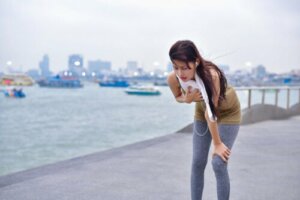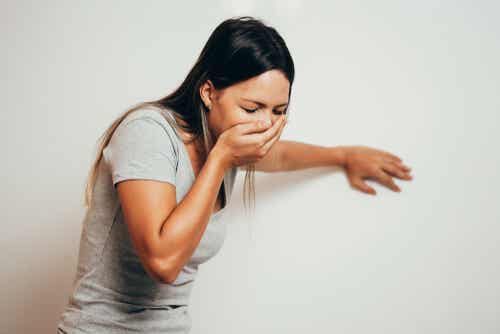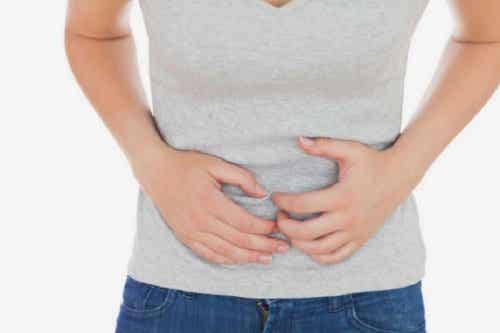Nausea After Exercise: Why Does It Occur?


Written and verified by the doctor Elisa Martin Cano
Nausea is a common sensation that appears after exercise. It can occur both in people who exercise frequently and in people who are out of shape. Different factors can cause it to appear. In this article, we’ll talk about the most frequent causes, as well as some measures to prevent nausea after exercise.
What is nausea?
Nausea’s an uncomfortable feeling in the upper abdomen or stomach followed by an urge to vomit. It’s very unpleasant and can last for minutes or even hours.
The causes of nausea can be many and varied. Some of them are gastrointestinal infections, but it’s even possible for it to arise as a side effect of some medications.
Now we’ll talk specifically about nausea after exercise. It can appear within minutes of performing a physical activity or during exercise itself. Moreover, it can occur both in athletes who are used to intense exercise as well as in people who are out of shape and don’t usually practice sports.
Why does nausea occur during exercise?
There are many physiological causes of nausea during or after exercise. Some of the most common are as follows.

Dehydration
When you exercise, especially at a certain intensity or during periods or times when it’s very hot, you sweat. Sweating is a physiological mechanism necessary for the regulation and maintenance of body temperature.
What happens is that when you sweat, you lose fluid and mineral salts. This loss causes your blood pressure to drop because blood is mostly made up of water. This can lead to nausea and dizziness.
It’s therefore very important to replenish the same amount of water and salts that you lose through sweating. You can do this by drinking water or isotonic drinks that keep your blood pressure stable. It’s crucial to drink liquids frequently and in short sips. You should do it before, during, and after you finish exercising.
You may be interested in: How Baking Soda Benefits Exercise
Hyperhydration
As we’ve said, it’s essential to stay properly hydrated, but you must bear in mind that excessive hydration also has side effects.
Adequate levels of both water and mineral salts are necessary to keep your blood pressure at the right levels and for your organs to function correctly. Among these, the most important for regulating your blood pressure is sodium.
When you drink too much water, the volume of liquid in your body increases, and what’s known as hypervolemia occurs. When this happens, the amount of salts present in your body is more diluted, so their concentration is lower.
As we’ve said, one of the most important substances is sodium. When the sodium concentration is lower than normal, nausea and discomfort occur. To avoid this, you’ll need to drink isotonic drinks that provide you with these salts.
Digestion cut

What’s popularly known as “digestion cut-off” has a physiological explanation. When we eat, the body dedicates a great part of its energy to digesting food. This happens especially with those foods that are rich in fats and proteins. To do this, it diverts a large proportion of blood from circulation to the stomach so that it can function at its best.
At the same time, when we exercise, the muscles also demand a large amount of energy because they need a lot of oxygen to perform movements and efforts. This is why, if we do physical activity shortly after a large meal, the gastrointestinal tract won’t receive all the blood it needs for digestion.
This situation also causes nausea and vomiting. To avoid this, it’s important not to eat large or very fatty meals 2 to 3 hours before high or moderate-intensity exercise.
You may be interested in: Four Great Post-Workout Drinks
Preventing nausea after exercise
Nausea is a very common symptom when exercising, so, in principle, there’s no need to be alarmed. However, when doing sports, we can take into account several measures to prevent discomfort.
It’s best not to eat too much 2 to 4 hours before exercise. We should also drink isotonic drinks during exercise to prevent the loss of water and mineral salts.
In addition, we should avoid being outside during the hottest hours of the day, especially in the summer season, when we’ll sweat more and dehydration can occur faster.
All cited sources were thoroughly reviewed by our team to ensure their quality, reliability, currency, and validity. The bibliography of this article was considered reliable and of academic or scientific accuracy.
- Rehidratación post-ejercicio: bebidas con alto contenido de potasio vs. agua y una bebida deportiva [Internet]. [cited 2020 May 24]. Available from: http://repositorio.ucr.ac.cr/handle/10669/567
- Marins JCB. Estudio comparativo de diferentes procedimientos de hidratación durante un ejercicio de larga duracion. 2000;1.
- Rabdomiólisis secundaria a hiponatremia [Internet]. [cited 2020 May 24]. Available from: http://scielo.isciii.es/scielo.php?pid=S0211-69952011000400022&script=sci_arttext&tlng=pt
- Ramírez Molina C. Mecanismos fisiológicos producidos en el sistema musculoesquelético desencadenados por la deshidratación durante el ejercicio físico. 2018 Jan 25;
This text is provided for informational purposes only and does not replace consultation with a professional. If in doubt, consult your specialist.








